According to research, a leaking faucet can ooze out more than 3,000 gallons of water yearly, dripping one drip per second. Such wastage is very detrimental to the ecosystem.
Did you know a significant percentage of all faucet leaks result from faulty cartridges?
A faucet cartridge regulates the flow of water out of the spout. Imagine what can happen when it malfunctions.
It can result in minor or severe leaks.
The good news is that faucet cartridge issues are easy to detect and fix.
But how will you know if a leak is from a broken water line or a faulty faucet cartridge?
Here are 13 ways to tell if a faucet cartridge is bad.
JUMP TO: Factors to Know That Cartridge is Bad | Why Does Faucet Cartridge Fail |
- There’s leakage from the spout, the faucet’s base, or under the sink
- You are finding it difficult to adjust the water pressure, and there’s some noise from the faucet
- The water pressure is poor, leading to an inconsistent stream of water
- There’s a foul smell from your faucet, and the temperature is inconsistent
Factors To Know That Faucet Cartridge is Bad
Faucet cartridges are pretty durable. The top-quality cartridges can last 10 to 15 years, while the lesser-quality ones should last at least five years.
If you suspect that your bathroom faucets cartridge are bad, here are 13 signs to look out for:
Leakage from the Spout
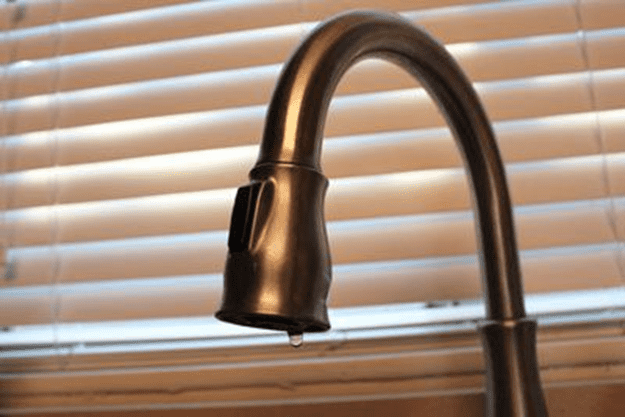
Source: the spruce
The easiest way to tell if a faucet cartridge is wrong is by checking for any leakage from the spout.
Look out for these three key signs of a leaky spout:
- The spout is still dripping water even after turning off the handles
- Having to tighten the faucet handle too much to minimize or stop the dripping
- Having to position the faucet handle in a particular way to stop the water flow
Sometimes, the leakage can be so minor that you don’t notice it. Here is a simple test you can do to check if your spout is leaking.
Dry your sink entirely with a kitchen towel. Then, place a dry napkin over the drainage hole.
Alternatively, place an empty cup directly below the spout. Leave it for about 10 minutes before checking.
If the napkin is slightly wet or there are some drops of water in the cup, your faucet spout is leaking. And it could be a sign that the faucet cartridge is faulty.
Note: The drip may appear minor and harmless initially, but it worsens with time. If left unattended, it could cause brown stains on your sink and perhaps increase your water bill. It could also result in a significant leak that will cost you more to repair.
The best thing to do is to have the leak inspected by a professional and the necessary repairs done early enough.
Related Read: Centerset Vs. Widespread Faucets
Leakage from the Faucet’s Base
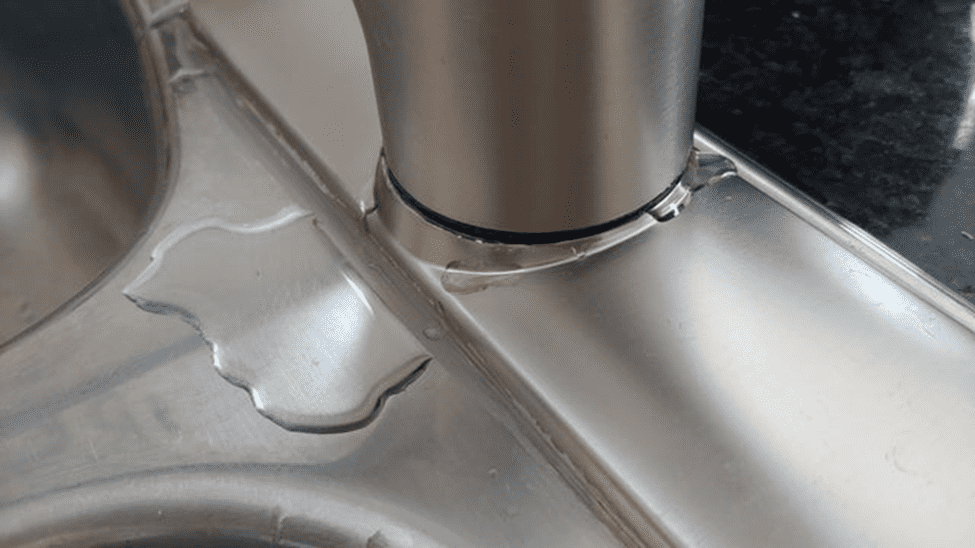
Source: reddit.com
The faucet base is where the spout attaches to the sink. Many people hardly notice leakage on the base because splash water often gets to this spot.
But if you often notice a puddle around your sink deck, it could indicate a leak. To be sure, carry out this little experiment:
Dry up the sink deck and the sink with a piece of cloth. Then, turn on the faucet handle and watch the base. If you see water trickling or forming a puddle around the base, it confirms that your base is indeed leaking.
A leaking base is often a result of a damaged O-ring, which affects the normal functioning of the cartridge.
Once you replace the O-ring with a new one, your faucet will be up and running perfectly.
Important Tip: Consider replacing the cartridge O-rings every ten years to prolong the life of your faucets.
Leakage Under the Sink
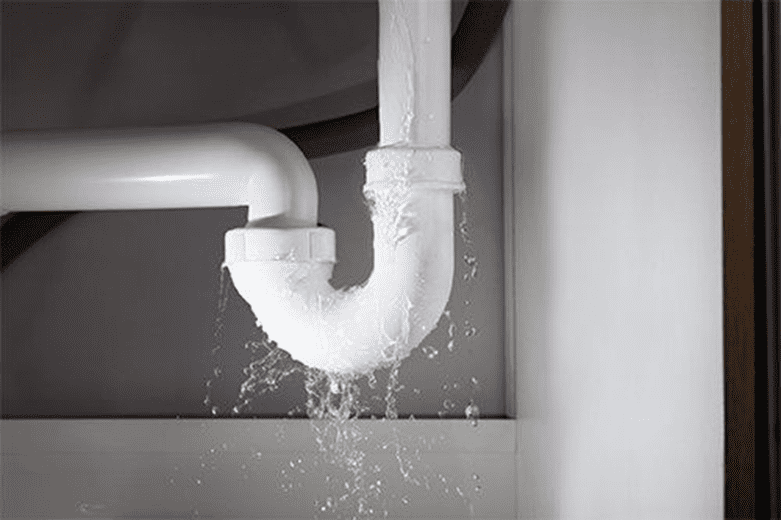
Source: O’fallon.com
When was the last time you checked under the sink?
Detecting leakage under the sink can take too long because many people rarely check!
Such leakages are also dangerous because water has nowhere to drain. The water seeps into the floor instead.
Water soaking into the floor could cause slipperiness, discoloration, and other extensive damage to the flooring material.
If you suspect that there could be a leakage under your sink, carry out this experiment:
Dry the compartment below the sink thoroughly. Then, open the tap and let the water run for some minutes. Observe to see if there is any water seeping under the sink.
If it’s taking too long to see any leakage, consider placing some paper towels on the floor beneath the sink. Leave them overnight and observe them the following morning.
If you find the paper towels soaked or observe watermarks, you probably leak them there.
There are several reasons why you may experience leakage under the sink. It could be worn-out cartridges, corroded internal parts, or loose fittings.
Call for professional help so they analyze the problem and advise on the best solution.
Inconsistent Water Temperatures
A double-handle faucet body comes with two handles, each with different temperatures. The left handle gives out the hot water, while the right handle lets out cold water.
A normal-working cartridge controls the flow and the temperature of the hot and cold water.
If the cartridge is defective, you will likely experience inconsistencies in water temperature. For example, you get cold water or lukewarm water instead of hot water from the left handle, and vice versa.
In such a scenario, it is advisable to change the cartridge.
Difficulty in Adjusting the Water Temperature
It is pretty difficult to adjust the water temperature to your liking when a faucet cartridge is terrible.
Sometimes, you may find it too hot water, and there is no way to regulate the heat.
Imagine, for example, you are in the shower. You are enjoying a warm, comfortable bath; the water suddenly gets cold or scalding hot. And it persists when you try to adjust it.
This situation is not only annoying but also dangerous. You could end up with severe burns due to hot water.
Difficulty adjusting the temperature of hot and cold water is often a result of a malfunctioning cartridge.
Failure to Produce a Steady Stream of Water
If your faucet is spitting out water rather than allowing it to flow in a steady stream, there is a problem somewhere.
It could be that the aerator is clogged or the cartridge, which controls the flow of water, is terrible.
Producing Some Noise
A faucet can produce different sounds based on the problem at hand. If your faucet has a screeching sound, the rubber washer is likely worn out and could affect the functioning of the cartridge.
Other sounds like clicking or clanking could mean possible cracks inside the faucet.
Presence of Rust and Mineral Deposits
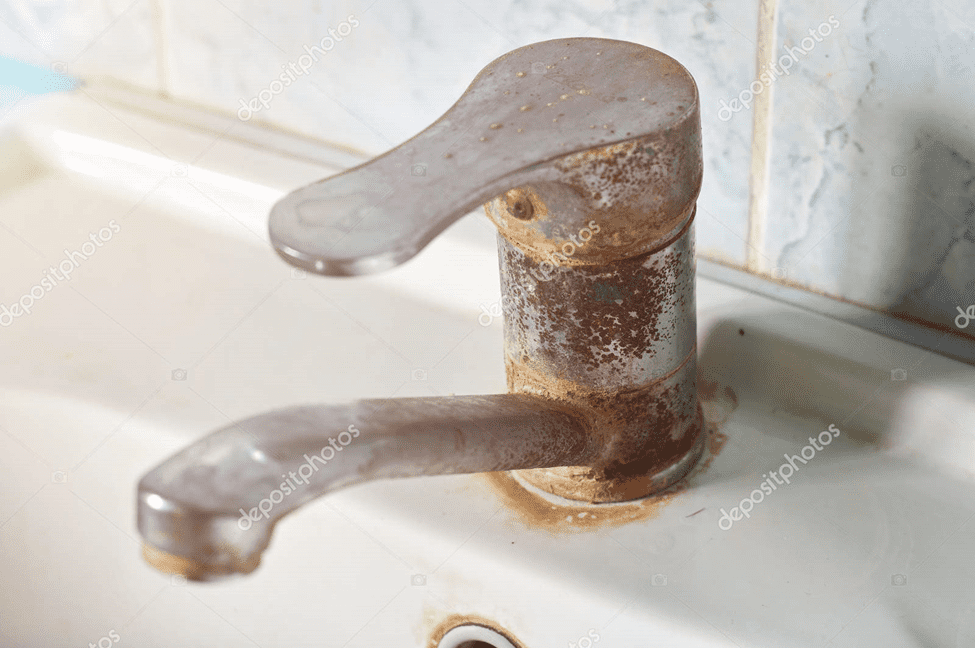
Source: Depositphotos
Rust and mineral deposits are notorious for faucet body damage. Mineral deposits mainly result from hard water passing through. They cause buildup inside or around the faucet cartridge and other internal plumbing fixtures like gaskets and filters.
Rust occurs over time when the internal fixtures lose their protective coating. It can cause the cartridge challenging to move or even damage it ultimately.
The best way to deal with rust and mineral deposits on a faucet cartridge is to replace it with a new one.
A Squeaky Handle
If the faucet stem is worn out, it causes the handle to make a squeaking sound. Sometimes the problem could result from a fault in the cartridge. So, consider disassembling the faucet to find out the actual source of the problem.
Water Tastes or Smells Bad
That is a red flag if your faucet water has a weird taste or smell. Check to see if all the faucets in your home have that particular taste or smell.
It could temporarily affect the water quality at the source or main distribution channel if they do. In this case, contacting your water company to check the problem would be good.
If the bad taste or smell is from one faucet, it could indicate that the faucet, cartridge, or piping has an issue.
Too much wear and tear inside the faucet affect the water’s taste and smell. For example, a worn-out faucet tends to get rusty. When water mixes with this rust, its smell and taste change.
In such a scenario, consider calling a professional plumber. They will diagnose the exact problem and make the necessary repairs.
Poor Water Pressure
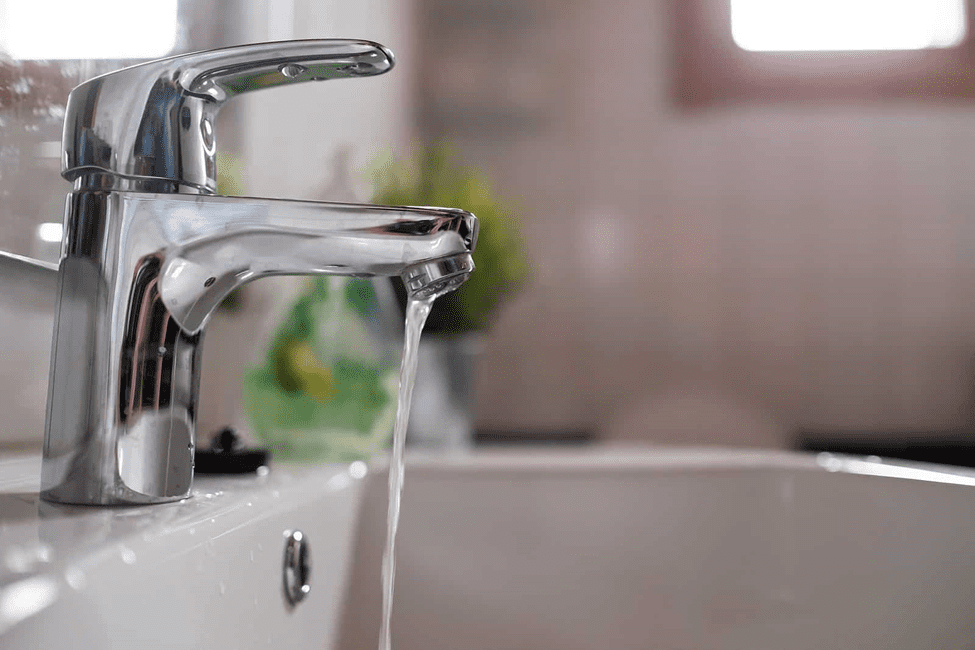
Source: Cardinal plumbing
According to the plumbing supply, the normal residential faucet water pressure ranges between 45 and 80 psi (pounds per square inch). If the pressure goes below 30 psi, consider it low pressure.
If you are experiencing abnormally low or high water pressure with a particular faucet, there could be an underlying problem.
Poor water pressure in one faucet can result from damaged cartridges, clogged pipes, hard water buildup, excessive corrosion, or inside leaks.
Caution: Detecting the exact cause could be hard for you. So, it would be good to seek professional help.
Mold Formation
Sometimes, you may not notice your faucet leaking until you see some mold around it. Such leaks could result from a lousy faucet cartridge.
The best way to repair a mold-damaged faucet is by replacing the entire faucet, including the cartridge.
Water Dripping
Dripping water from underneath the handle, the valve, or the nut is one of the most common signs of a bad faucet cartridge.
The leak could be minor (a few tiny drops) or major (flooding the entire floor). Either way, you need a professional plumber to diagnose a defective faucet cartridge.
Why Does a Faucet Cartridge Fail?
For a faucet cartridge to regulate water flow correctly, other parts within the faucet must also be working well. Here are several reasons why a faucet cartridge might fail:

Worn Out O-Ring
An O-ring is a piece of rubber with a torus shape located between the faucet and the cartridge. It acts as an obstacle that prevents water from dripping around the spout.
When the O-ring wears out, water will freely drip from the faucet as there is no more barrier. This problem is common as O-rings tend to wear out over time.
So, what should you do in case of a worn O-ring?
If the O-ring is the problem, replacing the entire faucet or cartridge is unnecessary. The solution is to replace the damaged O-ring with a new one. And the leak will stop!
Related Read: Are Faucet Aerators Universal?
Worn Out washer
Bathroom faucets have rubber washers beneath the valve stem, commonly known as valve seats.
A washer provides a barrier between the spout and the faucet’s seat. It prevents water from leaking when the tap is off.
Faucet washers often wear out over time due to frequent friction. As a result, you may notice some leakage around the faucet.
Another common reason for washer leakage is the installation of the wrong size.
What is the solution?
It is worth noting that washers come in different sizes and shapes. When you need to replace one, carrying the valve, and stem to the store is advisable to get a matching washer.
Loose Parts
Some parts within a faucet, more so screws, can get loose with time. This could result in water leaking from the base of the tap or dripping from the faucet spout.
You can disassemble the faucet handle to see if you can locate the leaking part. If you notice any loose screws, tighten them and see if the leakage stops.
Broken Pipes
Another common cause of cartridge failure is the breakage of the faucet’s piping system.
A broken pipe is notorious for causing a significant leaky faucet. It can cause immense damage to your floor, walls, and ceiling if not handled promptly.
The best way to handle broken pipes is to call a professional.
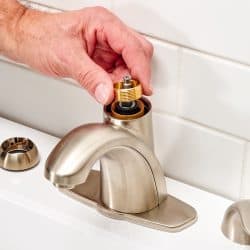
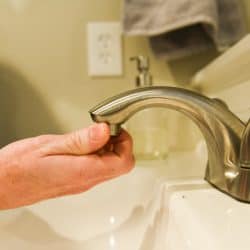
![How to Increase Water Pressure In My Kitchen Sink? [Methods Explained] How to Increase Water Pressure In My Kitchen Sink? [Methods Explained]](https://houseadorable.com/wp-content/uploads/2022/12/water2.jpg)
![Pull Down Vs. Pull Out Faucet [9 Major Differences Explained] Pull Down Vs. Pull Out Faucet [9 Major Differences Explained]](https://houseadorable.com/wp-content/uploads/2023/04/image4-3-250x250.jpg)
![[A] Water Heater Not Heating After Replacing Elements and Thermostat [A] Water Heater Not Heating After Replacing Elements and Thermostat](https://houseadorable.com/wp-content/uploads/2023/08/water-heater-not-heating-after-replacing-elements-1-250x250.png)
![16 Types of Kitchen Faucets Explained [With Pros + Cons] 16 Types of Kitchen Faucets Explained [With Pros + Cons]](https://houseadorable.com/wp-content/uploads/2023/02/Roca_griferia_cocina_mencia_negro_DEF_900x505_acf_cropped-1@2x-250x250.jpg)

![Centerset Vs. Widespread Faucets [8 Differences Explained] Centerset Vs. Widespread Faucets [8 Differences Explained]](https://houseadorable.com/wp-content/uploads/2023/03/1_332369605_6500081363358836_8480186754416832788_n-250x250.jpg)